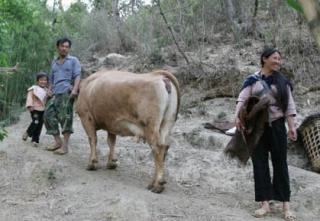
Who knew?
The largest, most-fatal outbreak of E. coli O157 or other shiga-toxin producing E. coli wasn’t sprouts in Germany in 2011, wasn’t roast beef in Scotland in 1996 or Ontario in 1985, wasn’t Japan in 1996 in radish sprouts.
It was in Xuzhou, China, in 1999: 177 dead, 195 hospitalized with hemolytic uremic syndrome. An estimate of the number sickened was not available.
A new paper by Chinese researchers examining the E. coli O157:H7 virulence factors involved in the outbreak strain dryly notes, “A less well known massive outbreak of O157:H7 occurred in, China, in 1999 … which has only  been reported in Chinese journals.”
been reported in Chinese journals.”
Those extra languages could really come in handy.
The authors write in PLoS ONE today that,
“The O157:H7 outbreak occurred between April and September and peaked in June, 1999 with 195 HUS cases and 177 deaths from 52 villages of seven counties in Jiangsu and neighboring Anhui province. Of the 195 cases, 167 (85.6%) were over 50 years old with only two less than 20 years old and 121 (62.1%) were female. The National Institute for Communicable Disease Control and Prevention, China CDC, commenced the outbreak investigation on June 28, 1999.
“Three and two strains of O157:H7 were isolated in Xuzhou city from fecal screening of 30 HUS and 25 diarrhea patients respectively. Thirty six sera collected from 42 HUS patients (85.7%) tested positive for IgG against EHEC-hemolysin or O157 lipopolysaccharide. Thus both bacterial and serological data confirmed that the outbreak was caused by O157:H7. The source of the infection was investigated using a case-control sample of 146 HUS patients and 840 healthy individuals, matched in age, sex and residence. No hand-washing before eating, consumption of fruits or vegetables without washing, consumption of leftover foods without heating, no fly-net cover for foods and high density of flies in kitchen were found to be statistically associated with infected patients. Using magnetic beads coated with antibodies against the O antigen, O157:H7 was isolated from six of 67 (9.0%) fly specimens, four of 74 (5.4%) raw meats and three of 83 (3.6%) cooked meats. O157:H7 was also isolated from live animals including 32 of 189 (16.9%) cattle, 50 of 605 (8.3%) pigs, 91 of 590 (15.4%) goats and 52 of 604 (8.6%) chickens raised in courtyards of families with and without HUS patients in the same villages.
“From the epidemiological investigations, the outbreak was mainly associated with peasants living with animals carrying O157:H7 in the household, including goats, pigs, chickens and cattle. Courtyard animals carrying O157:H7 contaminated the surrounding environment through fecal shedding and persons who had poor personal and kitchen hygiene practice were more likely to be infected. It is well established that farm animals are carriers of O157:H7. Additionally we found that 9% of the flies tested were positive for O157:H7 and thus they are important carriers in this outbreak. Flies may not just be mechanical vectors as O157:H7 can multiply inside the fly’s mouth and be excreted through fly fecal matter. Therefore poor hygiene and multiple routes of transmission may be the major  contributing factors to the massive outbreak. However, increased transmission would have expected to increase number of infections but not higher number of HUS rate and high mortality rate. Host factors may contribute to higher mortality with a disproportional number of HUS cases and deaths in the older age groups. We showed that the outbreak was caused by a new sequence type, ST96.”
contributing factors to the massive outbreak. However, increased transmission would have expected to increase number of infections but not higher number of HUS rate and high mortality rate. Host factors may contribute to higher mortality with a disproportional number of HUS cases and deaths in the older age groups. We showed that the outbreak was caused by a new sequence type, ST96.”
Abstract below:
A novel Escherichia coli O157:H7 clone causing a major hemolytic uremic syndrome outbreak in China***
30.apr.12
PLoS ONE 7(4): e36144.
Yanwen Xiong, Ping Wang, Ruiting Lan, Changyun Ye, Hua Wang, Jun Ren, Huaiqi Jing, Yiting Wang, Zhemin Zhou, Xuemei Bai, Zhigang Cui, Xia Luo, Ailan Zhao, Yan Wang, Shaomin Zhang, Hui Sun,Lei Wang, Jianguo Xu
http://www.plosone.org/article/info%3Adoi%2F10.1371%2Fjournal.pone.0036144
An Escherichia coli O157:H7 outbreak in China in 1999 caused 177 deaths due to hemolytic uremic syndrome. Sixteen outbreak associated isolates were found to belong to a new clone, sequence type 96 (ST96), based on multilocus sequence typing of 15 housekeeping genes. Whole genome sequencing of an outbreak isolate, Xuzhou21, showed that the isolate is phylogenetically closely related to the Japan 1996 outbreak isolate Sakai, both of which share the most recent common ancestor with the US outbreak isolate EDL933. The levels of IL-6 and IL-8 of peripheral blood mononuclear cells induced by Xuzhou21 and Sakai were significantly higher than that induced by EDL933. Xuzhou21 also induced a significantly higher level of IL-8 than Sakai while both induced similar levels of IL-6. The expression level of Shiga toxin 2 in Xuzhou21 induced by mitomycin C was 68.6 times of that under non-inducing conditions, twice of that induced in Sakai (32.7 times) and 15 times higher than that induced in EDL933 (4.5 times). Our study shows that ST96 is a novel clone and provided significant new insights into the evolution of virulence of E. coli O157:H7.
